
|

|
Other Fish in the Sea
by Lexi Krock
|

|
|

|

Ancient Creature homepage
|
|
Charles Darwin coined the phrase "living fossil" to describe the
ginkgo tree, whose distinctive wedge-shaped leaves are nearly
identical to those of fossilized ginkgos from the Triassic Period
240 million years ago. Today scientists have identified hundreds of
other living things that have persisted in an almost unchanged form
for millions of years, including giant sequoia trees, millipedes,
armadillos, crocodilians, and even some bacteria.
Among living fossil fish, the coelacanth is the most famous, but
there are many others. Perhaps even more than other kinds of living
fossils, these ancient fish, whose kind have swum the seas for more
than 450 million years, give scientists a window into what the Earth
was like an incomprehensibly long time ago. As the ancestors of all
vertebrates, they also provide important clues about the evolution
of many animals, even humans.
In this overview, learn about some of the living fossil fish that
have escaped the limelight.
|
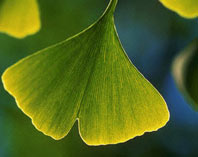
|
One of many "living fossils"—the ginkgo.
|
|
|
|
 Bichir
Bichir

Bichir are the only living fossil fish commonly kept as pets.
Bichir are bottom-dwelling freshwater fish native to western
Africa. They are among the most primitive of the ray-finned
fish, the dominant group of modern fish, which arose about 395
million years ago. A bichir's long, narrow body is commonly two to
three feet long and covered with thick, diamond-shaped scales made
of a shiny enamel-like substance called ganoine. Such scales were
also present in the earliest ray-finned fish and are different from
those of other living fish, except gar.
Like many of the other living fossil fish, the bichir is especially
adapted to life in dry environments. Instead of a regular swim
bladder it has a pair of modified "lungs," like those of the
lungfish, which enable it to survive out of water for several hours.
|
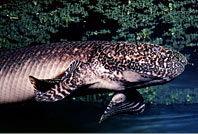
|
The meaning of the word "bichir" (pronounced
"be-SHEER"), the name African fishermen have used for
this fish since the early 19th century, is obscure, but
it is known to combine Arabic and French elements.

|
|
|
|
 Bowfin
Bowfin

Bowfin are normally ravenous eaters but they can go without eating
longer than any other fish—for nearly a year if
necessary—because of their low metabolisms.
There is only one living species of bowfin, which is also called the
dogfish, mudfish, or grindle. This uniquely American freshwater fish
is found in the Mississippi River basin, the Great Lakes, and other
small bodies of water east of the Great Lakes. It is a fierce
fighter with sharp teeth that is known to eat fish of all kinds as
well as frogs, snakes, turtles, and even small mammals. It also
sometimes cannibalizes other bowfin. Bowfin do not make good eating
but are considered good game fish.
Bowfin can use their swim bladders, which most other fish use as a
kind of flotation device, as a lung, allowing them to survive out of
water for up to a day. In oxygen-poor water, bowfin will often gulp
surface air in order to breathe. Paleontologists have discovered
fossilized bowfin from North America, South America, Europe, Africa,
and Asia, the earliest of which dates to the Jurassic Era, which
began 213 million years ago.
|
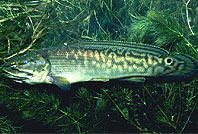
|
The main predator of bowfin are bigger bowfin.

|
|
|
|
 Gar
Gar

Gar eggs are lethally toxic to humans and other warm-blooded
vertebrates.
Gar (named for the Anglo-Saxon word for "spear") are freshwater fish
found in the warmer rivers and lakes of the southern U.S., Central
America, Mexico, and the West Indies. They are highly predaceous,
with long jaws and large, sharp teeth. They will attack any fish in
their path, lying perfectly still until they sense potential prey,
then striking and taking a "victory lap" or two around their kill.
Fishermen consider them a nuisance because they destroy many fish,
sometimes without bothering to eat them; they are also inedible.
Gar sport a fierce-looking armature of plate-like scales shaped like
diamonds, which are made of inorganic salt, like those of many
now-extinct fish. Like other primitive fish, the gar has a swim
bladder connected to its esophagus, which can be used for breathing.
|
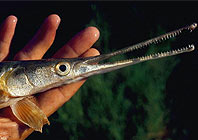
|
A needle-nosed gar caught from the Pecos River near
Carlsbad, New Mexico.

|
|
|
|
 Hagfish
Hagfish

The hagfish is the only vertebrate whose body fluids are the same
concentration as the surrounding seawater.
It is easy to see how this mud-dwelling, eel-like fish named for its
hideous appearance has been overshadowed by the comparatively comely
coelacanth. Also known as slime eels, hagfish are indigenous to both
the Atlantic and Pacific oceans, where they live at depths of 100 to
3,150 feet.
Eyeless, jawless, and dependent on their sense of smell to find
food, hagfish invade feeble or dead fish by entering through their
mouths and settling in their stomachs, where they secrete a slimy
substance that protects them from the digestive juices of their
hosts. They then eat their hosts from the inside out. Because
hagfish are soft-bodied, it has been difficult for scientists to
find and interpret evidence of their existence in the fossil record.
They believe, however, that this vertebrate's nearly identical
ancestor arose more than 550 million years ago, in the Precambrian
Era.
|
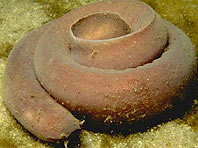
|
Hagfish are popular in South Korea, where almost five
million pounds of their meat is consumed every year.
Koreans also process hagfish skins into faux eelskin
boots, handbags, belts, and wallets.

|
|
|
|
 Lamprey
Lamprey

King Henry I of England died in Normandy in 1135 after gorging
himself on his favorite food: boiled lampreys.
Like hagfish, lampreys belong to the jawless fish, the most
primitive of all fish. Adult lampreys have a notochord, a
backbone-like structure that more-evolved vertebrates lose after the
embryonic stage.
Lampreys live in both freshwater and marine environments worldwide,
usually migrating from saltwater to freshwater to spawn. Some sea
lamprey populations have become landlocked and represent serious
pests to fishing industries. Adult lampreys parasitically attach
themselves to other fish, sucking out their body fluids after
scratching a hole with their sandpapery tongues. Lampreys have an
anticoagulant in their saliva that keeps the blood of their host
fluid, and some lampreys eat flesh as well. Their unwilling hosts
may eventually die.
|
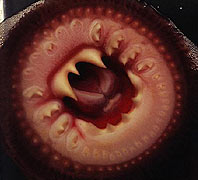
|
A lamprey can kill as much as 40 pounds of fish during
the 12 to 20 months of its adult life.

|
|
|
|
 Lungfish
Lungfish

The lungfish is the only living fossil fish to have a rock band
named after it.
The first living lungfish was discovered in the 1830s, almost a
century before the coelacanth appeared. Like the coelacanth, this
fish was previously thought to be extinct, because it was known only
from fossilized Devonian-Era remains almost 450 million years old.
The "lungs" of the lungfish are similar to those of land animals.
They are modified swim bladders, which most fish use for buoyancy
while swimming. Lungfish use theirs to absorb and conserve oxygen
from air. Modern lungfish, which are found in rivers and swamps in
Africa, South America, and Australia, can remain alive out of water
by using their swim bladders like lungs. They are so adapted to
living out of water that some species will drown if they are
deprived of air.
Scientists believe lungfish are the closest living relatives of
tetrapods—four-legged animals—with which they share a
number of important characteristics, including tooth enamel; the
arrangement of some skull bones; a separation of pulmonary-system
blood flow from blood flow throughout the rest of the body; and four
similarly sized limbs that have the same position and structure as
tetrapod legs.
|
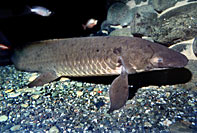
|
The Queensland lungfish inhabits the rivers of
southeastern Queensland, Australia.

|
|
|
|
 Paddlefish
Paddlefish

Spanish explorer Hernando de Soto discovered the paddlefish while
exploring the Mississippi River in the 16th century.
There are only two species of paddlefish, which are defined by their
large, paddle-shaped snouts. One is found in the Mississippi and the
other in China's Yangtze River. Scientists once thought that these
fish used their paddles to dig in muddy river bottoms or as a means
of providing balance in river currents. The paddle, though, is used
to gather sensory data, such as smells, tastes, and the electrical
fields given off by other fish and prey. Oddly enough, adult
paddlefish missing all or part of their paddle have no trouble
surviving.
Paddlefish are large, reaching up to 15 feet in length as adults.
They feed on crustaceans, and humans feed on them. North American
paddlefish used to reach weights of 300 pounds, but the species has
been overfished and now 100-pound paddlefish are considered large.
Unlike most modern fish, paddlefish have skins with few scales,
skeletons made almost wholly out of cartilage, and upturned tail
fins like those of sturgeon and sharks.
|
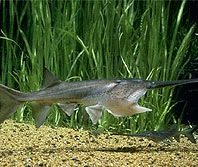
|
Paddlefish roe are important to the commercial caviar
business; indeed, much of the caviar that is sold as
sturgeon roe is actually paddlefish roe.

|
|
|
|
 Sturgeon
Sturgeon

The sturgeon is the largest freshwater fish in the world.
There are 24 species of sturgeon worldwide, the most famous of which
is the beluga sturgeon of the Caspian Sea, prized for its caviar.
Found in fresh and salt waters in the Northern Hemisphere, the
sturgeon is a bizarre-looking creature whose retractable mouth can
be projected like a miniature elephant trunk from the underside of
its head and whose body is armored with rows of thick plates. An
adult Pacific sturgeon can weigh 400 pounds and reach more than 20
feet in length. These fish can live well over 100 years.
In addition to their armored appearance, sturgeon have several
characteristics that are not found in modern fish and that mark them
as ancient. Though most modern bony fish have symmetrical tails (the
top and bottom lobes are the same size), sturgeon have asymmetric
tails like those of a shark. They also have notochords, lack scales,
and, like sharks, have spiral valves in their guts instead of
intestines.


|

|
The white sturgeon, native to the Pacific Ocean along
the U.S. coastline and the rivers of northern
California, is on the U.S. Endangered Species List.

|
|
Lexi Krock is assistant editor of NOVA online.


|

|
| |
|
|
|

